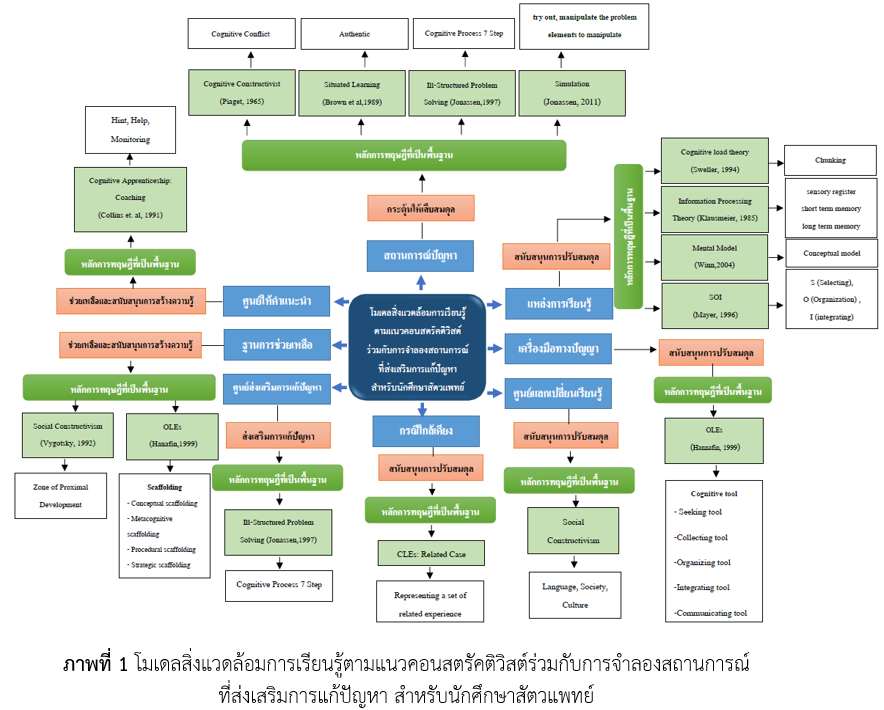การตรวจสอบความตรงของโมเดลสิ่งแวดล้อมการเรียนรู้ตามแนวคอนสตรัคติวิสต์ร่วมกับการจำลองสถานการณ์ที่ส่งเสริมการแก้ปัญหาสำหรับนักศึกษาสัตวแพทย์
Main Article Content
บทคัดย่อ
การแก้ปัญหาเป็นความสามารถของกระบวนการคิดเพื่อแก้ปัญหาของผู้เรียนในภารกิจการเรียนรู้ ซึ่งสำคัญอย่างยิ่งต่อวิชาชีพสัตวแพทย์ที่ต้องส่งเสริมการแก้ปัญหา การวิจัยในครั้งนี้มีวัตถุประสงค์เพื่อตรวจสอบความตรงของโมเดลสิ่งแวดล้อมการเรียนรู้ตามแนวคอนสตรัคติวิสต์ร่วมกับการจำลองสถานการณ์ที่ส่งเสริมการแก้ปัญหา สำหรับนักศึกษาสัตวแพทย์ ซึ่งประกอบไปด้วยความตรงภายใน และความตรงภายนอก ใช้รูปแบบการวิจัย คือ การวิจัยโมเดล ในระยะที่ 2 การตรวจสอบความตรงของโมเดล โดยความตรงภายในใช้การวิจัยแบบเชิงสำรวจ ส่วนความตรงภายนอกเป็นการวิจัยก่อนการทดลองที่มีการทดสอบหลังเรียน กลุ่มเป้าหมายประกอบด้วย 1) ผู้เชี่ยวชาญด้านวัดและประเมินผล 2) ผู้เชี่ยวชาญด้านประเมินคุณภาพโมเดลฯ 3) นักศึกษาสัตวแพทย์ชั้นปีที่ 5 คณะสัตวแพทยศาสตร์ มหาวิทยาลัยขอนแก่น ผลการวิจัยพบว่าโมเดลสิ่งแวดล้อมการเรียนรู้ฯ มีความตรงภายในโดยพบว่า การออกแบบองค์ประกอบของโมเดลในทุกองค์ประกอบมีความสอดคล้องกับหลักการทฤษฎีและกรอบแนวคิดที่ใช้เป็นพื้นฐานในการออกแบบและพัฒนา และมีความตรงภายนอกโดยพบว่า การแก้ปัญหาของผู้เรียน ผู้เรียนจำนวนร้อยละ 95 มีคะแนนสูงกว่าเกณฑ์ร้อยละ 70 ที่กำหนดไว้ ความสัมพันธ์ของการแก้ปัญหาของผู้เรียนกับผลสัมฤทธิ์ทางการเรียน พบว่า มีความสัมพันธ์กันเป็นทางบวก ในระดับน้อยโดยมีค่าสัมประสิทธิ์สหสัมพันธ์เท่ากับ 0.382 อย่างมีนัยสำคัญทางสถิติที่ระดับ .05 และความคิดเห็นของผู้เรียน พบว่า ผู้เรียนมีความคิดเห็นว่าสิ่งแวดล้อมการเรียนรู้ฯ มีความเหมาะสมต่อการเรียนรู้ที่ส่งเสริมการแก้ปัญหาทั้งในด้านเนื้อหา ด้านการออกแบบ และด้านสื่อบนเครือข่ายของโมเดลสิ่งแวดล้อมทางการเรียนรู้ตามแนวคอนสตรัคติวิสต์
Article Details

อนุญาตภายใต้เงื่อนไข Creative Commons Attribution-NonCommercial-NoDerivatives 4.0 International License.
วารสารวิทยาศาสตร์และวิทยาศาสตร์ศึกษา (JSSE) เป็นผู้ถือลิสิทธิ์บทความทุกบทความที่เผยแพร่ใน JSSE นี้ ทั้งนี้ ผู้เขียนจะต้องส่งแบบโอนลิขสิทธิ์บทความฉบับที่มีรายมือชื่อของผู้เขียนหลักหรือผู้ที่ได้รับมอบอำนาจแทนผู้เขียนทุกนให้กับ JSSE ก่อนที่บทความจะมีการเผยแพร่ผ่านเว็บไซต์ของวารสาร
แบบโอนลิขสิทธิ์บทความ (Copyright Transfer Form)
ทางวารสาร JSSE ได้กำหนดให้มีการกรอกแบบโอนลิขสิทธิ์บทความให้ครบถ้วนและส่งมายังกองบรรณาธิการในข้อมูลเสริม (supplementary data) พร้อมกับนิพนธ์ต้นฉบับ (manuscript) ที่ส่งมาขอรับการตีพิมพ์ ทั้งนี้ ผู้เขียนหลัก (corresponding authors) หรือผู้รับมอบอำนาจ (ในฐานะตัวแทนของผู้เขียนทุกคน) สามารถดำเนินการโอนลิขสิทธิ์บทความแทนผู้เขียนทั้งหมดได้ ซึ่งสามารถอัพโหลดไฟล์บทความต้นฉบับ (Manuscript) และไฟล์แบบโอนลิขสิทธิ์บทความ (Copyright Transfer Form) ในเมนู “Upload Submission” ดังนี้
1. อัพโหลดไฟล์บทความต้นฉบับ (Manuscript) ในเมนูย่อย Article Component > Article Text
2. อัพโหลดไฟล์แบบโอนลิขสิทธิ์บทความ (Copyright Transfer Form) ในเมนูย่อย Article Component > Other
ดาวน์โหลด ไฟล์แบบโอนลิขสิทธิ์บทความ (Copyright Transfer Form)
เอกสารอ้างอิง
Jonassen, D.H. (1997). Instructional design model for well-structured and ill-structured problem-solving learning outcomes. Educational Technology Research and Development, 45(1), 65-95.
Moeikao, N. (2018). Synthesis of designing framework for constructivist learning environments model to enhancing programming problem solving for connecting internet of thing devices. Lecture Notes in Computer Science (LNCS), 11003, 253-260.
Jarungsirawat, N. and Kanjug, I. (2020). The validation of online learning environments for enhancing mental model of programming (in Thai). Journal of Education Khon Kaen University, 43(4), 1-16.
Richey, R. C. and Klein, J. D. (2007). Design and development research methods, strategies, and issues. Mahwah, NJ: Lawrence Erlbaum Associates.
Syhalath, S. and Chaijaroen, S. (2018). The Design Framework of Constructivist Web-Based Learning Environment Model to Enhance Problem Solving for Higher Education Students in Laos (in Thai). Academic Services Journal, Prince of Songkla University, 29(1), 9-20.
Singha, P. and Chaijaroen, S. (2019). The validation of constructivist web-based learning environment model to enhance problem solving: Integration of pedagogy and neuroscience (in Thai). Academic Services Journal, Prince of Songkla University, 30(1), 22-31.
Wannapipat, W. and Chaijaroen, S. (2017). The Validation of the design and development of constructivist webbased-learning to enhance the undergraduate learning efficiency based on brain-based learning: Integrated with neuroscience (in Thai). Dhammathas Academic Journal, 17(3-Special), 165-176.


